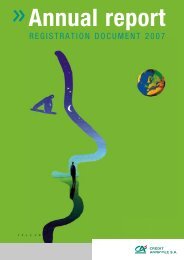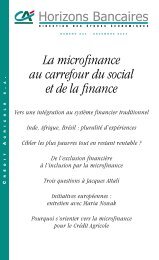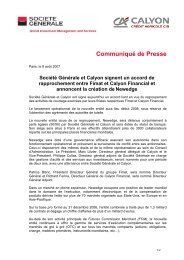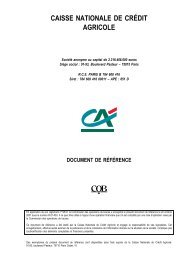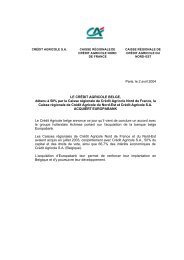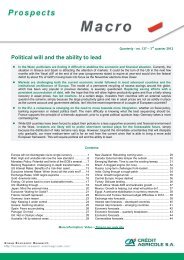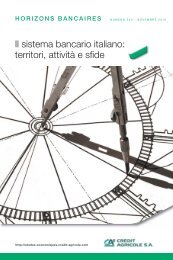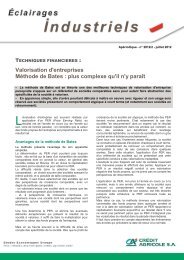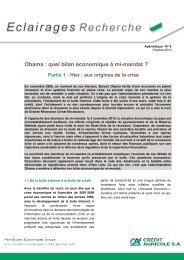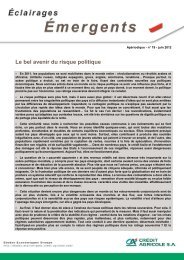PDF (3.77 Mo) - Le Crédit Agricole
PDF (3.77 Mo) - Le Crédit Agricole
PDF (3.77 Mo) - Le Crédit Agricole
Create successful ePaper yourself
Turn your PDF publications into a flip-book with our unique Google optimized e-Paper software.
Crédit <strong>Agricole</strong> S.A.Update of the 2011 registration document - A03Note 8 Fair value of financial instrumentsThe fair value of a financial instrument is the amount for which an asset could be exchanged, or a liabilitysettled, between knowledgeable, willing parties in an arm’s length transaction.The fair values shown below are estimates made on the reporting date. They are subject to change insubsequent periods due to developments in market conditions or other factors.The calculations represent best estimates. They are based on a number of valuation models andassumptions.To the extent that these models contain uncertainties, the fair values shown may not be achieved uponactual sale or immediate settlement of the financial instruments concerned.In practice, and in line with the going-concern principle, not all these financial instruments would necessarilybe settled immediately at the values estimated below.8.1 Fair value of financial assets and liabilities measured at amortised cost(in millionsof euros)Assets30/06/2012 31/12/2011CarryingamountEstimatedmarket valueCarryingamountEstimatedmarket valueLoans and receivables to credit institutions 401,931 408,243 379,841 385,241Loans and receivables to customers 402,551 413,536 399,381 404,354Held-to-maturity financial assets 15,188 17,358 15,343 16,908LiabilitiesDue to credit institutions 197,547 199,934 172,665 172,580Due to customers 526,732 527,046 525,636 525,750Debt securities 143,904 147,998 148,320 152,740Subordinated debt 30,497 30,568 33,782 29,961For financial instruments that are traded in an active market (i.e. prices are quoted and disseminated), thebest estimate of fair value is their market price.In the absence of a market and of reliable data, fair value is determined using an appropriate method that isconsistent with the valuation methods used in financial markets: market value of a comparable instrument,discounted future cash flows, or valuation models.Where it is necessary to assess market value, the discounted cash flow method is the most commonly used.In addition, it should be noted that Crédit <strong>Agricole</strong> S.A. Group took into account the experts’ report publishedby the IASB on 31 October 2008 on the valuation of certain financial instruments at fair value listed onmarkets that are no longer active.In some cases, market values are close to carrying amounts. This applies primarily to:• assets or liabilities at variable rates for which interest rates changes do not have a significant influence onthe fair value, since the rates on these instruments frequently correct themselves to the market rates;• short-term assets or liabilities where the redemption value is considered to be close to the market value;• regulated instruments (e.g. regulated savings accounts) where prices are fixed by the government;• demand liabilities;• transactions for which there are no reliable observable data.Page 186 sur 237



